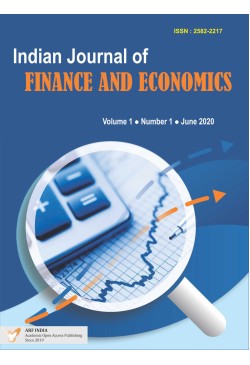
Indian Journal of Finance and Economics
Frequency :Bi-Annual
ISSN :2582-2217
Peer Reviewed Journal
AN EMPIRICAL ANALYSIS OF GROWTH AND DEVELOPMENT OF HIGHER EDUCATION IN SIKKIM
WOMEN BADI WORKERS AND THEIR LIVELIHOOD SUSTAINABILITY IN BADI MAKING BUSINESS IN KEONJHAR DISTRICT OF ODISHA
ENVIRONMENTAL POLLUTION AND THE EFFECTS OF AMBIENT CHARGES IN MIXED DUOPOLY MARKETS WITH DIVERSE FIRM OBJECTIVES
DEMOGRAPHIC INFLUENCE AND ROLE OF MICROFINANCE TOWARDS FAMILIAL EMPOWERMENT OF WOMEN – AN EMPIRICAL STUDY
INFLUENCE OF INTELLECTUAL CAPITAL ON COMPANY PERFORMANCE
DOES CUSTOMER TRUST MEDIATE THE IMPACT OF E-SERVICE QUALITY DIMENSIONS? LESSON DURING COVID-19 PANDEMIC
THE EFFECT OF EXCHANGE RATE UNCERTAINTY ON DOMESTIC INVESTMENT IN ETHIOPIA
THE EFFECT OF CENTRAL FINANCIAL TRANSFERS ON TAX EFFORTS OF STATES IN INDIA: A PANEL DATA ANALYSIS
THE IMPACT OF GENDER GAP INTO HOURLY WAGES: A STUDY BASED ON PRIVATE SECTOR COMPANIES IN SRI LANKA